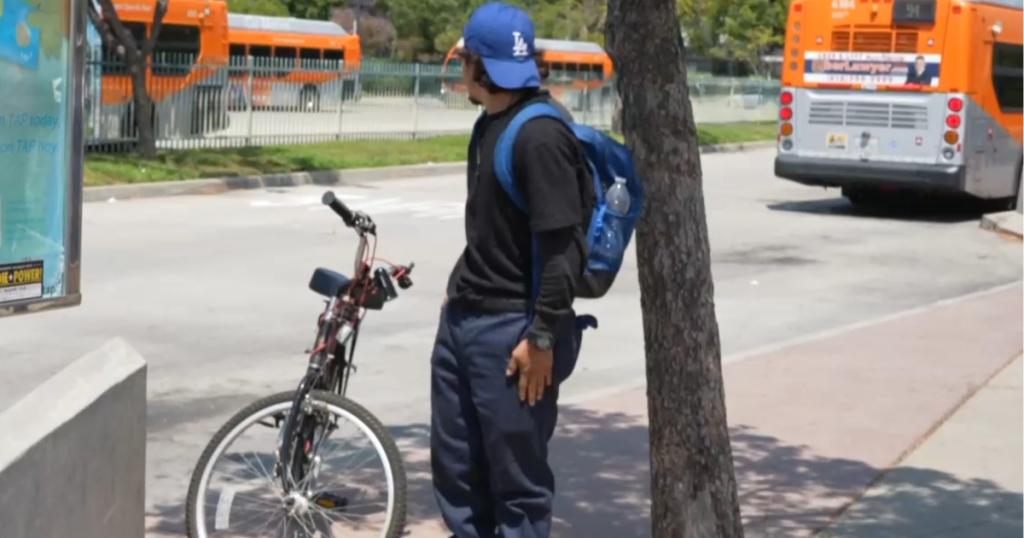In Los Angeles, the daily commute of Franchescoli Andrade has become a defining struggle of his life as he navigates a 20-mile journey to work without a car. Riding a bike, hopping on trains, and taking buses, he invests about 90 minutes for each leg of his trip. Andrade’s experience epitomizes the challenges many families face in California, as highlighted in a recent report that reveals the financial burdens on millions who struggle to make ends meet.
| Article Subheadings |
|---|
| 1) A Daily Commute: Franchescoli Andrade’s Struggle |
| 2) The Wider Impact: Transportation Challenges for California Families |
| 3) Financial Burdens: Cost of Living and Transportation |
| 4) Solutions and Barriers: The Complex Nature of Moving |
| 5) Future Aspirations: Andrade’s Hope for Change |
A Daily Commute: Franchescoli Andrade’s Struggle
For Franchescoli Andrade, the journey to work is arduous and exhausting. Residing in South Los Angeles and employed in the San Fernando Valley, he relies on multiple forms of transportation—his bicycle, a train, and a bus—to complete his daily commute. This 20-mile trek consumes precious time, totaling around 90 minutes for each leg of his journey. Such rigorous travel, alongside a heavy financial responsibility as the family’s sole provider, weighs heavily on Andrade.
Having once owned a car, the loss of this convenience struck a heavy blow after an accident left him unable to afford repairs. “Half an hour just to get to downtown, to get to the train station, then another half-an-hour just to get from the train station to get here,” he shared in a vivid recount of his daily life. The journey is not only a logistical challenge but also an emotional one, as he grapples with feelings of inadequacy while trying to support his family.
The Wider Impact: Transportation Challenges for California Families
Andrade’s story is far from isolated; it mirrors the plight of millions living in California, where financial strain is a widespread issue. A survey conducted by the nonprofit United Way revealed that around 35% of California households—approximately 3.8 million—do not earn enough to cover basic living expenses such as rent, groceries, and gas. This statistic provides a sobering context for Andrade’s own experiences.
According to United Way CEO Pete Manzo, “It’s a crisis we’ve been living with. It’s like we’re running a high fever.” He emphasizes that many hardworking families find themselves unable to achieve a respectable standard of living. This disparity raises critical questions about the structural issues within California’s economy and the availability of affordable resources.
Financial Burdens: Cost of Living and Transportation
The financial hurdles are compounded by transportation costs, which are steadily rising across the nation. The American Automobile Association (AAA) estimates that the average American household spends over $12,000 annually on car-related expenses, including monthly payments, insurance, maintenance, and fuel. This significant expenditure leaves families like Andrade’s with limited options, as journeying to work can reach about $1,000 a month.
Manzo articulates the dilemma succinctly: “You’re basically saying to a family, it’s going to be a $1,000 a month or more to get to and from work, to get to and from school.” While the costs might vary across states, inflation continues to escalate these financial challenges, making it harder for families to manage basic living expenses, let alone save for emergencies or future aspirations.
Solutions and Barriers: The Complex Nature of Moving
Amidst these overwhelming challenges, the suggestion for families to relocate to more affordable areas is complex. While it may offer a temporary solution for some, it ignites debates about the emotional and social repercussions of uprooting. Manzo points out that moving is often disruptive, affecting family relationships and community ties that are vital for emotional and social stability. Thus, advising families to simply “move somewhere more affordable” frequently lacks practical viability.
Future Aspirations: Andrade’s Hope for Change
Despite the daunting realities of his circumstances, Andrade remains hopeful. Currently, he is saving diligently in hopes of affording another car for his family, an aspiration that reflects broader ambitions for a better life. “They tell me, you know, don’t give up, you got this,” he said, encapsulating a spirit of resilience that characterizes many families facing similar trials. Andrade’s journey symbolizes not only individual struggle but also a collective necessity for systemic change and support.
| No. | Key Points |
|---|---|
| 1 | Franchescoli Andrade’s 20-mile commute highlights the struggles faced by many working families in California. |
| 2 | A significant portion of California households cannot afford basic living expenses, according to United Way’s findings. |
| 3 | Transportation costs are rising, further complicating economic challenges for families. |
| 4 | Suggesting relocation to more affordable areas is not always a practical solution for families. |
| 5 | Andrade’s determination to save for a new car highlights the resilience and hope of families in difficult situations. |
Summary
The experiences of Franchescoli Andrade shed light on a broader societal issue, revealing the intersection of economic hardship, transportation challenges, and family dynamics within California. His daily struggles echo the realities faced by millions and serve as a compelling call for systemic change. Community resilience is crucial, and initiatives aimed at alleviating these burdens could make a significant difference in the lives of struggling families.
Frequently Asked Questions
Question: What are the primary challenges faced by families in California?
Families in California often face economic hardships such as high living costs, inadequate wages, and transportation challenges that leave them struggling to meet basic needs.
Question: How does transportation impact financial stability?
Transportation can significantly strain a family’s budget, with many spending over $12,000 a year on car-related costs, thereby limiting the funds available for other essential expenses.
Question: What could reduce the burden of living costs for families?
Implementing systemic changes, such as affordable housing initiatives and accessible public transportation, could help alleviate the financial pressures that families are currently facing.
